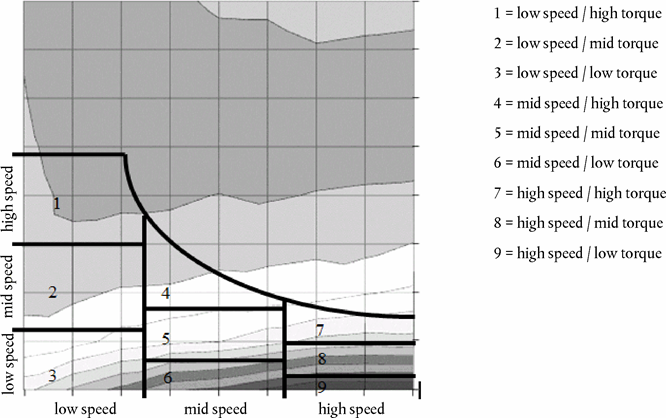6.Production conformity testing
6.1For conformity of the certified CO2 emissions and fuel consumption related properties testing, one of the following methods shall apply upon prior agreement between the approval authority and the applicant for a certificate:
Torque loss measurement according to this Annex by following the full procedure limited to the grid points described in 6.2.
Torque loss measurement according to this Annex by following the full procedure limited to the grid points described in 6.2, with exception of the run-in procedure. In order to consider the run-in characteristic of an axle, a corrective factor may be applied. This factor shall be determined according to good engineering judgement and with agreement of the approval authority.
Measurement of drag torque according to paragraph 6.3. The manufacturer may choose a run-in procedure according to good engineering judgement up to 100 h.
6.2If the conformity of the certified CO2 emissions and fuel consumption related properties assessment is performed according to 6.1. a) or b) the grid points for this measurement are limited to 4 grid points from the approved torque loss map.
6.2.1For that purpose the full torque loss map of the axle to be tested for conformity of the certified CO2 emissions and fuel consumption related properties shall be segmented into three equidistant speed ranges and three torque ranges in order to define nine control areas as shown in figure 2.
Figure 2 Speed and torque range for conformity of the certified CO2 emissions and fuel consumption related properties testing
6.2.2For four control areas one point shall be selected, measured and evaluated according to the full procedure as described in section 4.4. Each control point shall be selected in the following manner:
The control areas shall be selected depending on the axle line:
SR axles including tandem combinations: Control areas 5, 6, 8 and 9
HR axles including tandem combinations: Control areas 2, 3, 4 and 5
The selected point shall be located in the centre of the area referring to the speed range and the applicable torque range for the according speed.
In order to have a corresponding point for comparison with the loss map measured for certification, the selected point shall be moved to the closest measured point from the approved map.
6.2.3For each measured point of the conformity of the certified CO2 emissions and fuel consumption related properties test and its corresponding point of the type approved map, the efficiency shall be calculated with:
where:
=
Efficiency of the grid point from each single control area 1 to 9
=
Output torque [Nm]
=
Input torque [Nm]
=
axle ratio [-]
6.2.4The average efficiency of the control area shall be calculated as follows:
For SR axles:
For HR axles:
where:
=
average efficiency for low speed
=
average efficiency for mid speed
=
average efficiency for high speed
=
simplified averaged efficiency for axle
6.2.5If the conformity of the certified CO2 emissions and fuel consumption related properties assessment is performed in accordance with 6.1. c), the drag torque of the parent axle of the family to which the tested axle belongs shall be determined during the certification. This can be done prior to the run-in procedure or after the run-in procedure according to paragraph 3.1 or by linear extrapolation of all the torque map values for each speed step downwards to 0 Nm.
6.3Determination of drag torque
6.3.1For determination of the drag torque of an axle a simplified test set-up with one electric machine and one torque sensor on the input side is required.
6.3.2The test conditions according to paragraph 4.1 shall apply. The uncertainty calculation regarding torque may be omitted.
6.3.3The drag torque shall be measured in the speed range of the approved type according to paragraph 4.3.4 under consideration of the speed steps according to 4.3.5.
6.4.Conformity of the certified CO2 emissions and fuel consumption related properties test assessment
6.4.1A conformity of the certified CO2 emissions and fuel consumption related properties test is passed when one of the following conditions apply:
If a torque loss measurement according to 6.1(a) or (b) is conducted, the average efficiency of the tested axle during conformity of the certified CO2 emissions and fuel consumption related properties procedure shall not deviate more than 1,5 % for SR axles and 2,0 % for all other axles lines from corresponding average efficiency the type approved axle.
If a measurement of drag torque according to 6.1(c) is conducted, the deviation of the drag torque of the tested axle during conformity of the certified CO2 emissions and fuel consumption related properties procedure shall not be higher than indicated in table 2
Table 2
| Axleline | Tolerances for axles measured in CoP after run-inComparison to Td0 | Tolerances for axles measured in CoP without run inComparison to Td0 | ||||||
|---|---|---|---|---|---|---|---|---|
| for i | tolerance Td0_input [Nm] | for i | tolerance Td0_input [Nm] | for i | tolerance Td0_input Nm] | for i | tolerance Td0_input [Nm] | |
| SR | ≤ 3 | 15 | > 3 | 12 | ≤ 3 | 25 | > 3 | 20 |
| SRT | ≤ 3 | 16 | > 3 | 13 | ≤ 3 | 27 | > 3 | 21 |
| SP | ≤ 6 | 11 | > 6 | 10 | ≤ 6 | 18 | > 6 | 16 |
| HR | ≤ 7 | 10 | > 7 | 9 | ≤ 7 | 16 | > 7 | 15 |
| HRT | ≤ 7 | 11 | > 7 | 10 | ≤ 7 | 18 | > 7 | 16 |
=
gear ratio.








